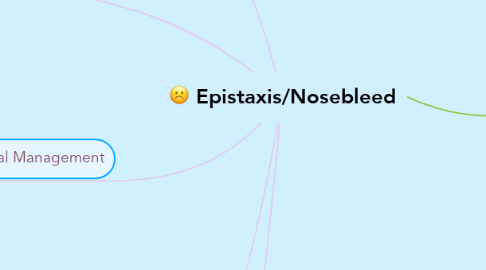Epistaxis/Nosebleed
by Britney Russell

1. Causes
1.1. • Exposure to warm, dry air, for long periods of air • Local infections (vestibuliitis, rhinitis, sinusitis) • Systemic infections (scarlet fever, malaria) • Drying of the nasal muscous membranes • Trauma (digital trauma as in picking of the nose) • Blunt trauma(fracture, forceful nose bleeding )
2. Signs of Excessive Blood Loss
2.1. • Dizziness • Weakness • Confusion • Fainting
3. Medical Management
3.1. 1. Direct pressure can be applied by pinching the soft outer portion of the nose against the middle septum for 5-10 minutes. The patient sits upright with the head tilted forward to prevent swallowing and aspiration of blood. 2 Nosebleeds can also be treated with a silver nitrate applicator and Gelfoam, or by electocautery. 4. Topical Vasoconstrictors can also be used to reduce blood flow and improved examiners view of bleeding site 5. The nose can be packed with petrolatum jelly or antibiotic filled gauze making sure to spray a topical anesthetic and decongestant agent before packing 6. A compressed nasal sponge many also be used to halt the bleeding.
4. Nursing Management
4.1. •Monitors the patient’s vital signs, assists, in the control of bleeding, and provides tissues and a basin to allow the patient to dis guard of any excess blood. • Ensure that the patients are calm • Continuously assess the patients airway, breathing and vital signs
5. Clinical Manifestation
5.1. The signs and symptoms of Epistaxis are redness around the nose, or bleeding which can sometimes be accompanied by a foul or purulent discharge if the object has been retained for sometime.
6. Caused by a hemorrhaging in the nose due to the rupturing of tiny, distended vessels in the mucous membrane of any area of the nose. Most commonly the site is the anterior septum where the three major blood vessels enter the nasal cavity:


